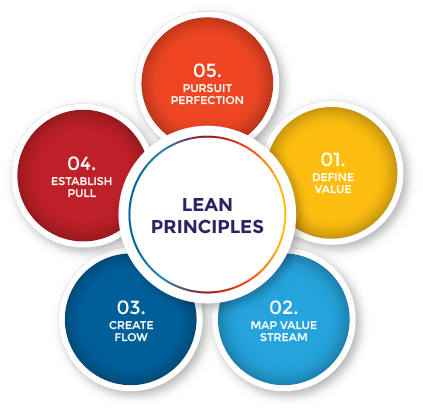
Lean principles
Last updated on 01st Oct 2020, Artciles, Blog
Lean manufacturing, or lean production, is a production method derived from Toyota’s 1930 operating model “The Toyota Way” (Toyota Production System, TPS). The term “Lean” was coined in 1988 by John Krafcik, and defined in 1996 by James Womack and Daniel Jones to consist of five key principles

Subscribe For Free Demo
Error: Contact form not found.
1. Define Value
To better understand the first principle of defining customer value, it is important to understand what value is. Value is what the customer is willing to pay for. It is paramount to discover the actual or latent needs of the customer. Sometimes customers may not know what they want or are unable to articulate it. This is especially common when it comes to novel products or technologies. There are many techniques such as interviews, surveys, demographic information, and web analytics that can help you decipher and discover what customers find valuable. By using these qualitative and quantitative techniques you can uncover what customers want, how they want the product or service to be delivered, and the price that they afford.
2. Map the Value Stream
The second Lean principle is identifying and mapping the value stream. In this step, the goal is to use the customer’s value as a reference point and identify all the activities that contribute to these values. Activities that do not add value to the end customer are considered waste. The waste can be broken into two categories: non-valued added but necessary and non-value & unnecessary. The later is pure waste and should be eliminated while the former should be reduced as much as possible. By reducing and eliminating unnecessary processes or steps, you can ensure that customers are getting exactly what they want while at the same time reducing the cost of producing that product or service.
3. Create Flow
After removing the wastes from the value stream, the following action is to ensure that the flow of the remaining steps run smoothly without interruptions or delays. Some strategies for ensuring that value-adding activities flow smoothly include: breaking down steps, reconfiguring the production steps, leveling out the workload, creating cross-functional departments, and training employees to be multi-skilled and adaptive.
4. Establish Pull
Inventory is considered one of the biggest wastes in any production system. The goal of a pull-based system is to limit inventory and work in process (WIP) items while ensuring that the requisite materials and information are available for a smooth flow of work. In other words, a pull-based system allows for Just-in-time delivery and manufacturing where products are created at the time that they are needed and in just the quantities needed. Pull-based systems are always created from the needs of the end customers. By following the value stream and working backwards through the production system, you can ensure that the products produced will be able to satisfy the needs of customers.
5. Pursue Perfection
Wastes are prevented through the achievement of the first four steps: 1) identifying value, 2) mapping value stream, 3) creating flow, and 4) adopting a pull system. However, the fifth step of pursuing perfection is the most important among them all. It makes Lean thinking and continuous process improvement a part of the organizational culture. Every employee should strive towards perfection while delivering products based on the customer needs. The company should be a learning organization and always find ways to get a little better each and every day.
What is waste in Lean Manufacturing?
A core principle in lean methodology is the removal of waste within an operation. And in any business, one of the heaviest drains on profitability is waste. Lean waste can come in the form of time, material, and labor. But it may also be related to the utilization of skill-sets as well as poor planning. In lean manufacturing, waste is any expense or effort that is expended but which does not transform raw materials into an item the customer is willing to pay for. By optimizing process steps and eliminating waste, only true value is added at each phase of production.
The Lean Manufacturing model recognizes 8 types of waste within an operation; seven originally conceived when the Toyota Production System was first conceived, and an eighth added when lean methodology was adopted within the Western World. Seven of the eight wastes are production process oriented, while the eighth waste is directly related to management’s ability to utilize personnel.
The 8 wastes of lean manufacturing include:
- Defects
- Excess Processing
- Overproduction
- Waiting
- Inventory
- Transportation
- Motion
- Non-Utilized Talent
Conclusion
The five Lean principles provide a framework for creating an efficient and effective organization. Lean allows managers to discover inefficiencies in their organization and deliver better value to customers. The principles encourage creating better flow in work processes and developing a continuous improvement culture. By practicing all 5 principles, an organization can remain competitive, increase the value delivered to the customers, decrease the cost of doing business, and increase their profitability.
Are you looking training with Right Jobs?
Contact Us- PMP Tutorial
- Lean Maturity Matrix Tutorial
- Lean Six Sigma Tutorial
Related Articles
Popular Courses
- PMP Certification Training
11025 Learners - CAPM Certification Training
12022 Learners - Jira Training
11141 Learners
- What is Dimension Reduction? | Know the techniques
- Difference between Data Lake vs Data Warehouse: A Complete Guide For Beginners with Best Practices
- What is Dimension Reduction? | Know the techniques
- What does the Yield keyword do and How to use Yield in python ? [ OverView ]
- Agile Sprint Planning | Everything You Need to Know
